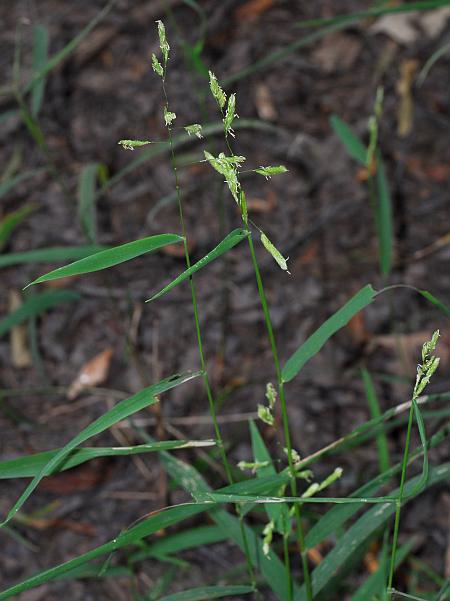Leersia lenticularis Michx.
Catchfly Grass, Oatmeal Grass

Native
CC = 7
CW = -5
MOC = 26
© SRTurner
Leersia lenticularis Michx.Catchfly Grass, Oatmeal Grass | |
 |
Native CC = 7 CW = -5 MOC = 26 |
© SRTurner |
|
Family - Poaceae/Oryzeae Habit - Perennial rhizomatous grass. Stem - Flowering stems to 1.7 m, mostly spreading, circular in cross-section or nearly so.
Leaves - Leaf sheaths open, smooth to somewhat roughened with minute, stiff, spinelike, downwardly pointed hairs. Leaf blades 10-35 cm long, 10-22 mm wide, the surfaces glabrous or soft-hairy, the margins noticeably sawtoothed with stiff, spinelike hairs. Ligule membranous, short.
Inflorescences - With 1 or less commonly 2 branches per node, with strongly overlapping spikelets.
Spikelets - Spikelets 3.8-5.6 mm long, 3-4 mm wide, broadly oval to nearly circular in outline, 1.0-1.8 times as long as wide, the lemma and palea with an "eyelash-like" fringe of hairs along the keel and other nerves. Stamens 2.
Fruits - Caryopses 3.5-4.0 mm long. Flowering - July - September. Habitat - Swamps, bottomland forests, sloughs, lake margins, ditches; often emergent aquatics. Origin - Native to the U.S. Lookalikes - L. oryzoides. Other info. - This grass's distribution in Missouri is biphasic, being found in most counties bordering the Mississippi River and also in a belt running diagonally through the northwestern region of the state. Its larger range is largely defined by the Mississippi River and the Gulf and Atlantic coastal plains. This is one of the easier grasses to identify due to the aligned, overlapping, flattened spikelets resembling turtles on a log (thanks to Rick Gray for this useful mnemonic), and the eyelash fringe of hairs on the edges of the spikelets. The spikelets are nearly circular and larger than those of the other two Missouri species of Leersia. Though closely related to rice cutgrass (L. oryzoides), this species is not as injurious to bare skin. Photographs taken at Otter Slough Conservation Area, Stoddard County, MO, 9-8-2019 (SRTurner). |